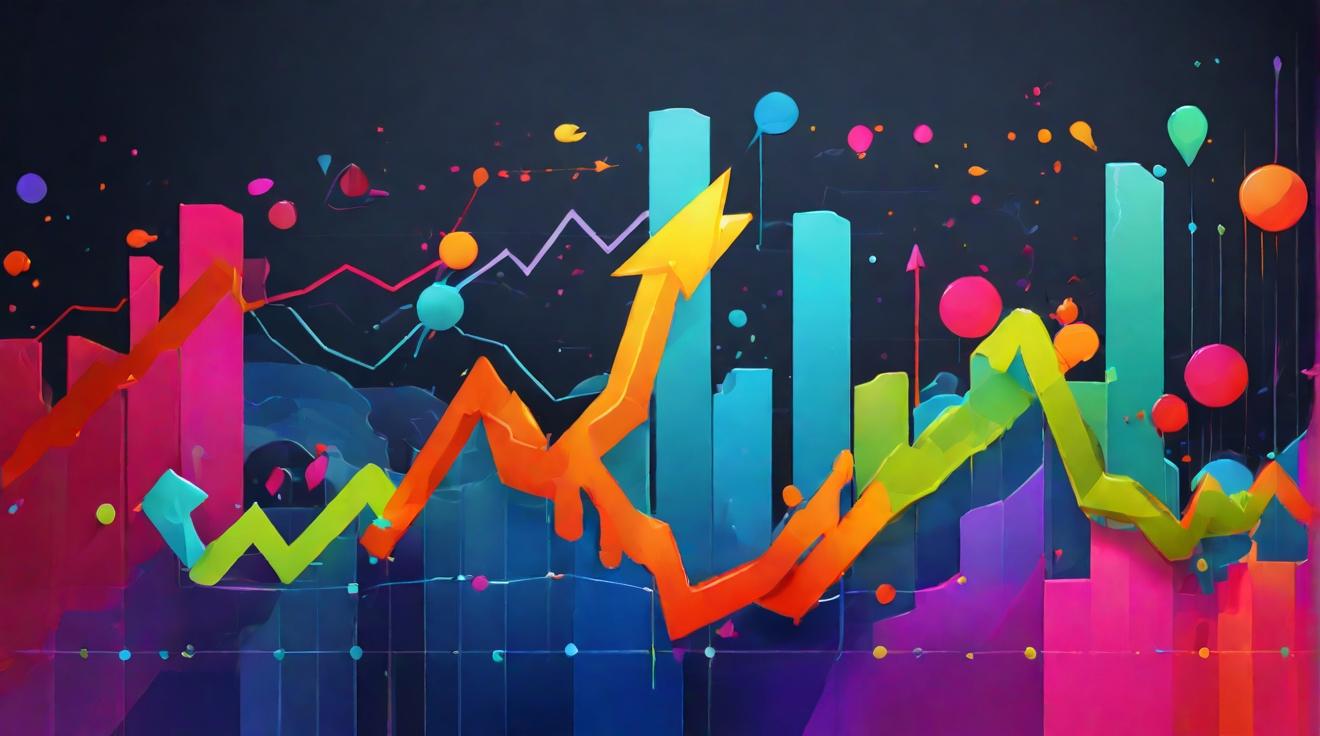On the positive side, the OECD noted that easing trade restrictions or accelerated adoption of artificial intelligence technologies could enhance growth prospects globally. !-- wp:paragraph -->
FinOracleAI — Market View
The OECD’s upward revision of global and U.S. growth forecasts reflects unexpected resilience in emerging markets and technology-driven investment, particularly in AI. However, the persistent threat of tariff escalation and policy uncertainty remains a significant drag. Inflationary pressures linked to tariffs could challenge central banks’ efforts to stabilize prices. !-- wp:paragraph -->- Opportunities: Accelerated AI adoption, easing of trade barriers, fiscal stimulus in key emerging markets.
- Risks: Escalating tariffs, trade policy uncertainty, inflation rebound, financial market volatility, fiscal deficits.
Impact: The revised forecasts suggest moderate economic growth amid elevated risks. Investors and policymakers should monitor tariff developments and inflation trends closely, as these will heavily influence market dynamics and policy responses over the coming year.
The OECD revised its inflation forecast for the G20 countries down slightly to 3.4% for 2025, compared with 3.6% in its previous report. The U.S. inflation outlook was adjusted more sharply downward to 2.7% from 3.2%. !-- wp:paragraph --> However, the risk of renewed inflationary pressures remains, fueled by ongoing tariff increases and fiscal vulnerabilities in various economies. The report also highlighted financial market repricing risks and the potential threats posed by volatile crypto-asset valuations. !-- wp:paragraph -->Potential Upside: Trade and Technology
On the positive side, the OECD noted that easing trade restrictions or accelerated adoption of artificial intelligence technologies could enhance growth prospects globally. !-- wp:paragraph -->FinOracleAI — Market View
The OECD’s upward revision of global and U.S. growth forecasts reflects unexpected resilience in emerging markets and technology-driven investment, particularly in AI. However, the persistent threat of tariff escalation and policy uncertainty remains a significant drag. Inflationary pressures linked to tariffs could challenge central banks’ efforts to stabilize prices. !-- wp:paragraph -->- Opportunities: Accelerated AI adoption, easing of trade barriers, fiscal stimulus in key emerging markets.
- Risks: Escalating tariffs, trade policy uncertainty, inflation rebound, financial market volatility, fiscal deficits.
Impact: The revised forecasts suggest moderate economic growth amid elevated risks. Investors and policymakers should monitor tariff developments and inflation trends closely, as these will heavily influence market dynamics and policy responses over the coming year.
The OECD revised its inflation forecast for the G20 countries down slightly to 3.4% for 2025, compared with 3.6% in its previous report. The U.S. inflation outlook was adjusted more sharply downward to 2.7% from 3.2%. !-- wp:paragraph --> However, the risk of renewed inflationary pressures remains, fueled by ongoing tariff increases and fiscal vulnerabilities in various economies. The report also highlighted financial market repricing risks and the potential threats posed by volatile crypto-asset valuations. !-- wp:paragraph -->Potential Upside: Trade and Technology
On the positive side, the OECD noted that easing trade restrictions or accelerated adoption of artificial intelligence technologies could enhance growth prospects globally. !-- wp:paragraph -->FinOracleAI — Market View
The OECD’s upward revision of global and U.S. growth forecasts reflects unexpected resilience in emerging markets and technology-driven investment, particularly in AI. However, the persistent threat of tariff escalation and policy uncertainty remains a significant drag. Inflationary pressures linked to tariffs could challenge central banks’ efforts to stabilize prices. !-- wp:paragraph -->- Opportunities: Accelerated AI adoption, easing of trade barriers, fiscal stimulus in key emerging markets.
- Risks: Escalating tariffs, trade policy uncertainty, inflation rebound, financial market volatility, fiscal deficits.
Impact: The revised forecasts suggest moderate economic growth amid elevated risks. Investors and policymakers should monitor tariff developments and inflation trends closely, as these will heavily influence market dynamics and policy responses over the coming year.
Since May, the effective U.S. tariff rate has risen sharply to an estimated 19.5% by the end of August, the highest level since 1933. Many tariffs are still being phased in, with companies initially absorbing some costs, but the economic impact is becoming increasingly evident in consumer prices, labor markets, and spending behavior. !-- wp:paragraph --> Labour markets in multiple countries are showing signs of softening, including rising unemployment and fewer job openings. Meanwhile, the disinflation trend appears to have plateaued. !-- wp:paragraph -->“The tariff shock is bringing more inflationary pressures in many countries,” said Alvaro Pereira, OECD chief economist. “We expect additional price impacts for firms not only in the United States but also globally.”Inflation Outlook and Fiscal Challenges
The OECD revised its inflation forecast for the G20 countries down slightly to 3.4% for 2025, compared with 3.6% in its previous report. The U.S. inflation outlook was adjusted more sharply downward to 2.7% from 3.2%. !-- wp:paragraph --> However, the risk of renewed inflationary pressures remains, fueled by ongoing tariff increases and fiscal vulnerabilities in various economies. The report also highlighted financial market repricing risks and the potential threats posed by volatile crypto-asset valuations. !-- wp:paragraph -->Potential Upside: Trade and Technology
On the positive side, the OECD noted that easing trade restrictions or accelerated adoption of artificial intelligence technologies could enhance growth prospects globally. !-- wp:paragraph -->FinOracleAI — Market View
The OECD’s upward revision of global and U.S. growth forecasts reflects unexpected resilience in emerging markets and technology-driven investment, particularly in AI. However, the persistent threat of tariff escalation and policy uncertainty remains a significant drag. Inflationary pressures linked to tariffs could challenge central banks’ efforts to stabilize prices. !-- wp:paragraph -->- Opportunities: Accelerated AI adoption, easing of trade barriers, fiscal stimulus in key emerging markets.
- Risks: Escalating tariffs, trade policy uncertainty, inflation rebound, financial market volatility, fiscal deficits.
Impact: The revised forecasts suggest moderate economic growth amid elevated risks. Investors and policymakers should monitor tariff developments and inflation trends closely, as these will heavily influence market dynamics and policy responses over the coming year.
Despite the positive revisions, the OECD cautioned that significant risks persist. Elevated tariff rates and ongoing policy uncertainty continue to weigh on investment and global trade. !-- wp:paragraph --> Since May, the effective U.S. tariff rate has risen sharply to an estimated 19.5% by the end of August, the highest level since 1933. Many tariffs are still being phased in, with companies initially absorbing some costs, but the economic impact is becoming increasingly evident in consumer prices, labor markets, and spending behavior. !-- wp:paragraph --> Labour markets in multiple countries are showing signs of softening, including rising unemployment and fewer job openings. Meanwhile, the disinflation trend appears to have plateaued. !-- wp:paragraph -->“The tariff shock is bringing more inflationary pressures in many countries,” said Alvaro Pereira, OECD chief economist. “We expect additional price impacts for firms not only in the United States but also globally.”Inflation Outlook and Fiscal Challenges
The OECD revised its inflation forecast for the G20 countries down slightly to 3.4% for 2025, compared with 3.6% in its previous report. The U.S. inflation outlook was adjusted more sharply downward to 2.7% from 3.2%. !-- wp:paragraph --> However, the risk of renewed inflationary pressures remains, fueled by ongoing tariff increases and fiscal vulnerabilities in various economies. The report also highlighted financial market repricing risks and the potential threats posed by volatile crypto-asset valuations. !-- wp:paragraph -->Potential Upside: Trade and Technology
On the positive side, the OECD noted that easing trade restrictions or accelerated adoption of artificial intelligence technologies could enhance growth prospects globally. !-- wp:paragraph -->FinOracleAI — Market View
The OECD’s upward revision of global and U.S. growth forecasts reflects unexpected resilience in emerging markets and technology-driven investment, particularly in AI. However, the persistent threat of tariff escalation and policy uncertainty remains a significant drag. Inflationary pressures linked to tariffs could challenge central banks’ efforts to stabilize prices. !-- wp:paragraph -->- Opportunities: Accelerated AI adoption, easing of trade barriers, fiscal stimulus in key emerging markets.
- Risks: Escalating tariffs, trade policy uncertainty, inflation rebound, financial market volatility, fiscal deficits.
Impact: The revised forecasts suggest moderate economic growth amid elevated risks. Investors and policymakers should monitor tariff developments and inflation trends closely, as these will heavily influence market dynamics and policy responses over the coming year.
Despite the positive revisions, the OECD cautioned that significant risks persist. Elevated tariff rates and ongoing policy uncertainty continue to weigh on investment and global trade. !-- wp:paragraph --> Since May, the effective U.S. tariff rate has risen sharply to an estimated 19.5% by the end of August, the highest level since 1933. Many tariffs are still being phased in, with companies initially absorbing some costs, but the economic impact is becoming increasingly evident in consumer prices, labor markets, and spending behavior. !-- wp:paragraph --> Labour markets in multiple countries are showing signs of softening, including rising unemployment and fewer job openings. Meanwhile, the disinflation trend appears to have plateaued. !-- wp:paragraph -->“The tariff shock is bringing more inflationary pressures in many countries,” said Alvaro Pereira, OECD chief economist. “We expect additional price impacts for firms not only in the United States but also globally.”Inflation Outlook and Fiscal Challenges
The OECD revised its inflation forecast for the G20 countries down slightly to 3.4% for 2025, compared with 3.6% in its previous report. The U.S. inflation outlook was adjusted more sharply downward to 2.7% from 3.2%. !-- wp:paragraph --> However, the risk of renewed inflationary pressures remains, fueled by ongoing tariff increases and fiscal vulnerabilities in various economies. The report also highlighted financial market repricing risks and the potential threats posed by volatile crypto-asset valuations. !-- wp:paragraph -->Potential Upside: Trade and Technology
On the positive side, the OECD noted that easing trade restrictions or accelerated adoption of artificial intelligence technologies could enhance growth prospects globally. !-- wp:paragraph -->FinOracleAI — Market View
The OECD’s upward revision of global and U.S. growth forecasts reflects unexpected resilience in emerging markets and technology-driven investment, particularly in AI. However, the persistent threat of tariff escalation and policy uncertainty remains a significant drag. Inflationary pressures linked to tariffs could challenge central banks’ efforts to stabilize prices. !-- wp:paragraph -->- Opportunities: Accelerated AI adoption, easing of trade barriers, fiscal stimulus in key emerging markets.
- Risks: Escalating tariffs, trade policy uncertainty, inflation rebound, financial market volatility, fiscal deficits.
Impact: The revised forecasts suggest moderate economic growth amid elevated risks. Investors and policymakers should monitor tariff developments and inflation trends closely, as these will heavily influence market dynamics and policy responses over the coming year.
The OECD attributed the stronger-than-expected global economic performance in the first half of 2025 to several factors. Emerging-market economies, particularly Brazil, Indonesia, and India, demonstrated remarkable resilience. Additionally, front-loading of industrial production and trade activities ahead of tariff hikes supported growth. !-- wp:paragraph --> Significant investment related to artificial intelligence in the United States further bolstered economic outcomes. Fiscal stimulus measures in China helped offset challenges posed by trade tensions and weaknesses in the property market. !-- wp:paragraph -->“Global growth was more resilient than anticipated in the first half of 2025, especially in many emerging-market economies,” the OECD noted in its latest report.Tariff Hikes and Trade Uncertainty Cloud Outlook
Despite the positive revisions, the OECD cautioned that significant risks persist. Elevated tariff rates and ongoing policy uncertainty continue to weigh on investment and global trade. !-- wp:paragraph --> Since May, the effective U.S. tariff rate has risen sharply to an estimated 19.5% by the end of August, the highest level since 1933. Many tariffs are still being phased in, with companies initially absorbing some costs, but the economic impact is becoming increasingly evident in consumer prices, labor markets, and spending behavior. !-- wp:paragraph --> Labour markets in multiple countries are showing signs of softening, including rising unemployment and fewer job openings. Meanwhile, the disinflation trend appears to have plateaued. !-- wp:paragraph -->“The tariff shock is bringing more inflationary pressures in many countries,” said Alvaro Pereira, OECD chief economist. “We expect additional price impacts for firms not only in the United States but also globally.”Inflation Outlook and Fiscal Challenges
The OECD revised its inflation forecast for the G20 countries down slightly to 3.4% for 2025, compared with 3.6% in its previous report. The U.S. inflation outlook was adjusted more sharply downward to 2.7% from 3.2%. !-- wp:paragraph --> However, the risk of renewed inflationary pressures remains, fueled by ongoing tariff increases and fiscal vulnerabilities in various economies. The report also highlighted financial market repricing risks and the potential threats posed by volatile crypto-asset valuations. !-- wp:paragraph -->Potential Upside: Trade and Technology
On the positive side, the OECD noted that easing trade restrictions or accelerated adoption of artificial intelligence technologies could enhance growth prospects globally. !-- wp:paragraph -->FinOracleAI — Market View
The OECD’s upward revision of global and U.S. growth forecasts reflects unexpected resilience in emerging markets and technology-driven investment, particularly in AI. However, the persistent threat of tariff escalation and policy uncertainty remains a significant drag. Inflationary pressures linked to tariffs could challenge central banks’ efforts to stabilize prices. !-- wp:paragraph -->- Opportunities: Accelerated AI adoption, easing of trade barriers, fiscal stimulus in key emerging markets.
- Risks: Escalating tariffs, trade policy uncertainty, inflation rebound, financial market volatility, fiscal deficits.
Impact: The revised forecasts suggest moderate economic growth amid elevated risks. Investors and policymakers should monitor tariff developments and inflation trends closely, as these will heavily influence market dynamics and policy responses over the coming year.
The OECD attributed the stronger-than-expected global economic performance in the first half of 2025 to several factors. Emerging-market economies, particularly Brazil, Indonesia, and India, demonstrated remarkable resilience. Additionally, front-loading of industrial production and trade activities ahead of tariff hikes supported growth. !-- wp:paragraph --> Significant investment related to artificial intelligence in the United States further bolstered economic outcomes. Fiscal stimulus measures in China helped offset challenges posed by trade tensions and weaknesses in the property market. !-- wp:paragraph -->“Global growth was more resilient than anticipated in the first half of 2025, especially in many emerging-market economies,” the OECD noted in its latest report.Tariff Hikes and Trade Uncertainty Cloud Outlook
Despite the positive revisions, the OECD cautioned that significant risks persist. Elevated tariff rates and ongoing policy uncertainty continue to weigh on investment and global trade. !-- wp:paragraph --> Since May, the effective U.S. tariff rate has risen sharply to an estimated 19.5% by the end of August, the highest level since 1933. Many tariffs are still being phased in, with companies initially absorbing some costs, but the economic impact is becoming increasingly evident in consumer prices, labor markets, and spending behavior. !-- wp:paragraph --> Labour markets in multiple countries are showing signs of softening, including rising unemployment and fewer job openings. Meanwhile, the disinflation trend appears to have plateaued. !-- wp:paragraph -->“The tariff shock is bringing more inflationary pressures in many countries,” said Alvaro Pereira, OECD chief economist. “We expect additional price impacts for firms not only in the United States but also globally.”Inflation Outlook and Fiscal Challenges
The OECD revised its inflation forecast for the G20 countries down slightly to 3.4% for 2025, compared with 3.6% in its previous report. The U.S. inflation outlook was adjusted more sharply downward to 2.7% from 3.2%. !-- wp:paragraph --> However, the risk of renewed inflationary pressures remains, fueled by ongoing tariff increases and fiscal vulnerabilities in various economies. The report also highlighted financial market repricing risks and the potential threats posed by volatile crypto-asset valuations. !-- wp:paragraph -->Potential Upside: Trade and Technology
On the positive side, the OECD noted that easing trade restrictions or accelerated adoption of artificial intelligence technologies could enhance growth prospects globally. !-- wp:paragraph -->FinOracleAI — Market View
The OECD’s upward revision of global and U.S. growth forecasts reflects unexpected resilience in emerging markets and technology-driven investment, particularly in AI. However, the persistent threat of tariff escalation and policy uncertainty remains a significant drag. Inflationary pressures linked to tariffs could challenge central banks’ efforts to stabilize prices. !-- wp:paragraph -->- Opportunities: Accelerated AI adoption, easing of trade barriers, fiscal stimulus in key emerging markets.
- Risks: Escalating tariffs, trade policy uncertainty, inflation rebound, financial market volatility, fiscal deficits.
Impact: The revised forecasts suggest moderate economic growth amid elevated risks. Investors and policymakers should monitor tariff developments and inflation trends closely, as these will heavily influence market dynamics and policy responses over the coming year.
The Organisation for Economic Co-operation and Development (OECD) has upgraded its forecast for global economic growth in 2025 to 3.2%, an increase from the 2.9% projection made in June. Despite this upward revision, the forecast for 2026 remains unchanged at 2.9%, indicating a modest slowdown from the estimated 3.3% growth achieved in 2024. !-- wp:paragraph --> The U.S. economy is also expected to perform better than previously anticipated, with the OECD raising its 2025 growth forecast to 1.8% from 1.6%. Nonetheless, this still represents a notable deceleration compared to the 2.8% growth recorded in 2024. The outlook for 2026 predicts a further slowdown to 1.5% growth. !-- wp:paragraph -->Key Drivers Behind the Upward Revision
The OECD attributed the stronger-than-expected global economic performance in the first half of 2025 to several factors. Emerging-market economies, particularly Brazil, Indonesia, and India, demonstrated remarkable resilience. Additionally, front-loading of industrial production and trade activities ahead of tariff hikes supported growth. !-- wp:paragraph --> Significant investment related to artificial intelligence in the United States further bolstered economic outcomes. Fiscal stimulus measures in China helped offset challenges posed by trade tensions and weaknesses in the property market. !-- wp:paragraph -->“Global growth was more resilient than anticipated in the first half of 2025, especially in many emerging-market economies,” the OECD noted in its latest report.Tariff Hikes and Trade Uncertainty Cloud Outlook
Despite the positive revisions, the OECD cautioned that significant risks persist. Elevated tariff rates and ongoing policy uncertainty continue to weigh on investment and global trade. !-- wp:paragraph --> Since May, the effective U.S. tariff rate has risen sharply to an estimated 19.5% by the end of August, the highest level since 1933. Many tariffs are still being phased in, with companies initially absorbing some costs, but the economic impact is becoming increasingly evident in consumer prices, labor markets, and spending behavior. !-- wp:paragraph --> Labour markets in multiple countries are showing signs of softening, including rising unemployment and fewer job openings. Meanwhile, the disinflation trend appears to have plateaued. !-- wp:paragraph -->“The tariff shock is bringing more inflationary pressures in many countries,” said Alvaro Pereira, OECD chief economist. “We expect additional price impacts for firms not only in the United States but also globally.”Inflation Outlook and Fiscal Challenges
The OECD revised its inflation forecast for the G20 countries down slightly to 3.4% for 2025, compared with 3.6% in its previous report. The U.S. inflation outlook was adjusted more sharply downward to 2.7% from 3.2%. !-- wp:paragraph --> However, the risk of renewed inflationary pressures remains, fueled by ongoing tariff increases and fiscal vulnerabilities in various economies. The report also highlighted financial market repricing risks and the potential threats posed by volatile crypto-asset valuations. !-- wp:paragraph -->Potential Upside: Trade and Technology
On the positive side, the OECD noted that easing trade restrictions or accelerated adoption of artificial intelligence technologies could enhance growth prospects globally. !-- wp:paragraph -->FinOracleAI — Market View
The OECD’s upward revision of global and U.S. growth forecasts reflects unexpected resilience in emerging markets and technology-driven investment, particularly in AI. However, the persistent threat of tariff escalation and policy uncertainty remains a significant drag. Inflationary pressures linked to tariffs could challenge central banks’ efforts to stabilize prices. !-- wp:paragraph -->- Opportunities: Accelerated AI adoption, easing of trade barriers, fiscal stimulus in key emerging markets.
- Risks: Escalating tariffs, trade policy uncertainty, inflation rebound, financial market volatility, fiscal deficits.
Impact: The revised forecasts suggest moderate economic growth amid elevated risks. Investors and policymakers should monitor tariff developments and inflation trends closely, as these will heavily influence market dynamics and policy responses over the coming year.
The Organisation for Economic Co-operation and Development (OECD) has upgraded its forecast for global economic growth in 2025 to 3.2%, an increase from the 2.9% projection made in June. Despite this upward revision, the forecast for 2026 remains unchanged at 2.9%, indicating a modest slowdown from the estimated 3.3% growth achieved in 2024. !-- wp:paragraph --> The U.S. economy is also expected to perform better than previously anticipated, with the OECD raising its 2025 growth forecast to 1.8% from 1.6%. Nonetheless, this still represents a notable deceleration compared to the 2.8% growth recorded in 2024. The outlook for 2026 predicts a further slowdown to 1.5% growth. !-- wp:paragraph -->Key Drivers Behind the Upward Revision
The OECD attributed the stronger-than-expected global economic performance in the first half of 2025 to several factors. Emerging-market economies, particularly Brazil, Indonesia, and India, demonstrated remarkable resilience. Additionally, front-loading of industrial production and trade activities ahead of tariff hikes supported growth. !-- wp:paragraph --> Significant investment related to artificial intelligence in the United States further bolstered economic outcomes. Fiscal stimulus measures in China helped offset challenges posed by trade tensions and weaknesses in the property market. !-- wp:paragraph -->“Global growth was more resilient than anticipated in the first half of 2025, especially in many emerging-market economies,” the OECD noted in its latest report.Tariff Hikes and Trade Uncertainty Cloud Outlook
Despite the positive revisions, the OECD cautioned that significant risks persist. Elevated tariff rates and ongoing policy uncertainty continue to weigh on investment and global trade. !-- wp:paragraph --> Since May, the effective U.S. tariff rate has risen sharply to an estimated 19.5% by the end of August, the highest level since 1933. Many tariffs are still being phased in, with companies initially absorbing some costs, but the economic impact is becoming increasingly evident in consumer prices, labor markets, and spending behavior. !-- wp:paragraph --> Labour markets in multiple countries are showing signs of softening, including rising unemployment and fewer job openings. Meanwhile, the disinflation trend appears to have plateaued. !-- wp:paragraph -->“The tariff shock is bringing more inflationary pressures in many countries,” said Alvaro Pereira, OECD chief economist. “We expect additional price impacts for firms not only in the United States but also globally.”Inflation Outlook and Fiscal Challenges
The OECD revised its inflation forecast for the G20 countries down slightly to 3.4% for 2025, compared with 3.6% in its previous report. The U.S. inflation outlook was adjusted more sharply downward to 2.7% from 3.2%. !-- wp:paragraph --> However, the risk of renewed inflationary pressures remains, fueled by ongoing tariff increases and fiscal vulnerabilities in various economies. The report also highlighted financial market repricing risks and the potential threats posed by volatile crypto-asset valuations. !-- wp:paragraph -->Potential Upside: Trade and Technology
On the positive side, the OECD noted that easing trade restrictions or accelerated adoption of artificial intelligence technologies could enhance growth prospects globally. !-- wp:paragraph -->FinOracleAI — Market View
The OECD’s upward revision of global and U.S. growth forecasts reflects unexpected resilience in emerging markets and technology-driven investment, particularly in AI. However, the persistent threat of tariff escalation and policy uncertainty remains a significant drag. Inflationary pressures linked to tariffs could challenge central banks’ efforts to stabilize prices. !-- wp:paragraph -->- Opportunities: Accelerated AI adoption, easing of trade barriers, fiscal stimulus in key emerging markets.
- Risks: Escalating tariffs, trade policy uncertainty, inflation rebound, financial market volatility, fiscal deficits.
Impact: The revised forecasts suggest moderate economic growth amid elevated risks. Investors and policymakers should monitor tariff developments and inflation trends closely, as these will heavily influence market dynamics and policy responses over the coming year.
OECD Revises Up Global and U.S. Growth Projections
The Organisation for Economic Co-operation and Development (OECD) has upgraded its forecast for global economic growth in 2025 to 3.2%, an increase from the 2.9% projection made in June. Despite this upward revision, the forecast for 2026 remains unchanged at 2.9%, indicating a modest slowdown from the estimated 3.3% growth achieved in 2024. !-- wp:paragraph --> The U.S. economy is also expected to perform better than previously anticipated, with the OECD raising its 2025 growth forecast to 1.8% from 1.6%. Nonetheless, this still represents a notable deceleration compared to the 2.8% growth recorded in 2024. The outlook for 2026 predicts a further slowdown to 1.5% growth. !-- wp:paragraph -->Key Drivers Behind the Upward Revision
The OECD attributed the stronger-than-expected global economic performance in the first half of 2025 to several factors. Emerging-market economies, particularly Brazil, Indonesia, and India, demonstrated remarkable resilience. Additionally, front-loading of industrial production and trade activities ahead of tariff hikes supported growth. !-- wp:paragraph --> Significant investment related to artificial intelligence in the United States further bolstered economic outcomes. Fiscal stimulus measures in China helped offset challenges posed by trade tensions and weaknesses in the property market. !-- wp:paragraph -->“Global growth was more resilient than anticipated in the first half of 2025, especially in many emerging-market economies,” the OECD noted in its latest report.Tariff Hikes and Trade Uncertainty Cloud Outlook
Despite the positive revisions, the OECD cautioned that significant risks persist. Elevated tariff rates and ongoing policy uncertainty continue to weigh on investment and global trade. !-- wp:paragraph --> Since May, the effective U.S. tariff rate has risen sharply to an estimated 19.5% by the end of August, the highest level since 1933. Many tariffs are still being phased in, with companies initially absorbing some costs, but the economic impact is becoming increasingly evident in consumer prices, labor markets, and spending behavior. !-- wp:paragraph --> Labour markets in multiple countries are showing signs of softening, including rising unemployment and fewer job openings. Meanwhile, the disinflation trend appears to have plateaued. !-- wp:paragraph -->“The tariff shock is bringing more inflationary pressures in many countries,” said Alvaro Pereira, OECD chief economist. “We expect additional price impacts for firms not only in the United States but also globally.”Inflation Outlook and Fiscal Challenges
The OECD revised its inflation forecast for the G20 countries down slightly to 3.4% for 2025, compared with 3.6% in its previous report. The U.S. inflation outlook was adjusted more sharply downward to 2.7% from 3.2%. !-- wp:paragraph --> However, the risk of renewed inflationary pressures remains, fueled by ongoing tariff increases and fiscal vulnerabilities in various economies. The report also highlighted financial market repricing risks and the potential threats posed by volatile crypto-asset valuations. !-- wp:paragraph -->Potential Upside: Trade and Technology
On the positive side, the OECD noted that easing trade restrictions or accelerated adoption of artificial intelligence technologies could enhance growth prospects globally. !-- wp:paragraph -->FinOracleAI — Market View
The OECD’s upward revision of global and U.S. growth forecasts reflects unexpected resilience in emerging markets and technology-driven investment, particularly in AI. However, the persistent threat of tariff escalation and policy uncertainty remains a significant drag. Inflationary pressures linked to tariffs could challenge central banks’ efforts to stabilize prices. !-- wp:paragraph -->- Opportunities: Accelerated AI adoption, easing of trade barriers, fiscal stimulus in key emerging markets.
- Risks: Escalating tariffs, trade policy uncertainty, inflation rebound, financial market volatility, fiscal deficits.
Impact: The revised forecasts suggest moderate economic growth amid elevated risks. Investors and policymakers should monitor tariff developments and inflation trends closely, as these will heavily influence market dynamics and policy responses over the coming year.













